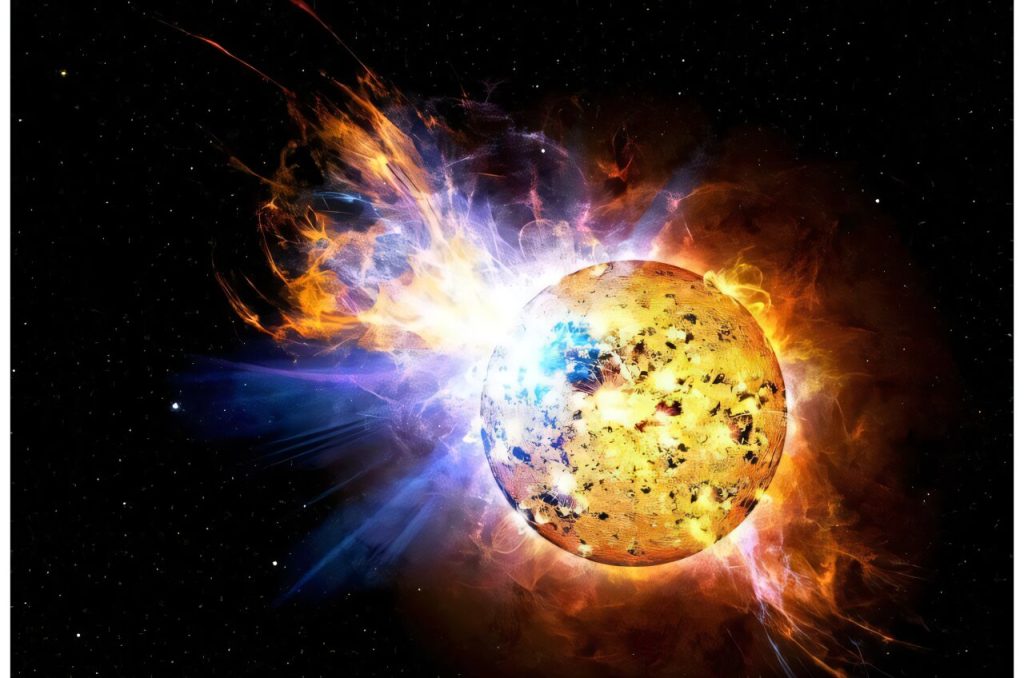
May 2024 super geomagnetic storm challenges current space weather prediction models (Image Credit: Phys.org)
During May 2024, a series of eruption events on the sun saw the largest geomagnetic storm hit Earth in two decades. The largest since the solar storms of Halloween 2003, it occurred from May 10 to May 13, producing aurorae as far south as the Canary Islands off Africa, the Florida Keys in the United States, and the Yucatán Peninsula in Mexico. On the other side of the world, the Aurora australis was seen in Queensland, Australia, Namibia and southern Brazil, among many other places.
Now scientists have unraveled the solar and interplanetary origins of these events by combining observations from satellite and Earth imaging, providing more support for the idea that solar superstorms are “perfect storms,” said Ying Liu, the paper’s lead author from the University of Chinese Academy of Sciences in Beijing.
“The 2024 May superstorm was produced by a pileup of coronal mass ejections, rather than a single coronal mass ejection (CME). It is essentially a ‘perfect storm,’ i.e., a combination of circumstances resulting in an event of an unusual magnitude.” Their work has been published in The Astrophysical Journal Letters.
The last several months seem to have been the peak of the current solar cycle, which is labeled cycle 25. It has been stronger than solar cycle 24, which peaked in early 2014, but weaker than the other sunspot peaks since 1970.
In the first third of May 2024, a large and complex “active region” on the sun came about from the merging of two complex, active groups of sunspots which had appeared at the end of April and the beginning of May. On May 13, this active region disappeared behind the west limb of the sun as it rotated to the sun’s backside, as seen from Earth. But in the days before, as it rotated from east to west on the sun’s surface, producing M/X class solar flares and coronal mass ejections.
The letter classification for solar flares refers to the maximum amount of soft X-ray electromagnetic energy they carry outward per square meter of space (“flux”), with X class flares carrying about 10 times the maximum flux than do M class flares.
In addition, the active regions produced coronal mass ejections, which are gatherings of superheated matter (“plasma”) ejected from the sun that travel outward through space, sometimes in the direction of Earth.
When CMEs reach the magnetic region that surrounds Earth, they cause geomagnetic storms and can damage electric power grids and, by influencing the ionosphere, some radio and broadcast equipment. The most intense such storm ever observed was the Carrington Event of 1859, which allowed some telegraph transmissions to work without electricity and even caused sparking and fires in some telegraph stations.

One way solar scientists measure the intensity of geomagnetic storms is with the Disturbance storm time index, labeled Dst. It is a measure of the strength of the ring current around Earth caused by solar protons and electrons; the ring current produces a magnetic field that is directly opposite Earth’s magnetic field, and Dst measures how much the Earth’s magnetic field is weakened, expressed as a negative number.
The May 2024 geomagnetic storm had a Dst of -412 nT (nanoteslas; for comparison, at its surface Earth’s magnetic field is about 45,000 nT). The 2023 Halloween solar storm had a Dst of about -401 nT, and the Carrington Event is estimated to have a Dst between -850 nT.
Using the STEREO A satellite, the last active of a pair of identical satellites that orbit the sun, the solar active region produced successive halo CMEs.
The research team was able to obtain key findings regarding the formation of solar superstorms and how intermediate variations of CMEs affect “geo-effectiveness” on Earth, which is the ability of a CME to cause geomagnetic storms above Earth. One was mentioned above, supporting the hypothesis that solar superstorms are perfect storms in nature.
They also note that historical records of some extreme solar events support this hypothesis as well, such as the 1859 Carrington Event and the March 1989 storm (which caused a nine-hour outage of an electricity distribution system in Quebec, Canada), with both resulting from successive CMEs from the same active regions of the sun.
The first complex ejections in May 2024 showed “considerable differences in the magnetic field and associated geo-effectiveness between Earth and STEREO A,” the group wrote, despite only an intermediate distance between sunspots. And two different cases of complex ejections had contrasting geo-effectiveness on Earth, which the group concludes “is largely due to different magnetic field configurations within the same active region.”
“The results imply…that extreme events are more frequent than we imagine,” said Liu, reinforcing that they support the “perfect storm” hypothesis he developed with colleagues in 2019.
“The nature and frequency of solar superstorms challenge the current models and techniques used to predict space weather, and they also raise serious concerns about what we should do in terms of infrastructure development in order to be better prepared for extreme space weather.”
More information:
Ying D. Liu et al, A Pileup of Coronal Mass Ejections Produced the Largest Geomagnetic Storm in Two Decades, The Astrophysical Journal Letters (2024). DOI: 10.3847/2041-8213/ad7ba4
Journal information:
Astrophysical Journal Letters
© 2024 Science X Network





